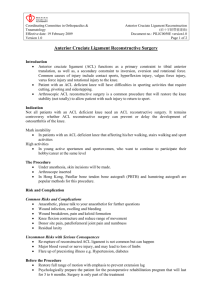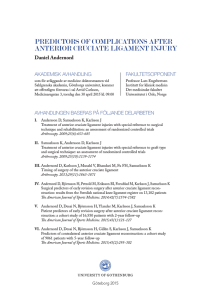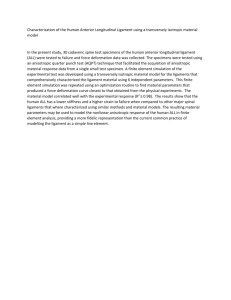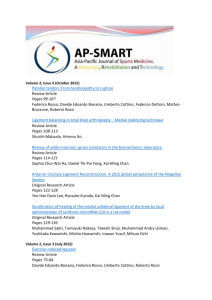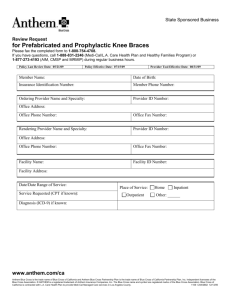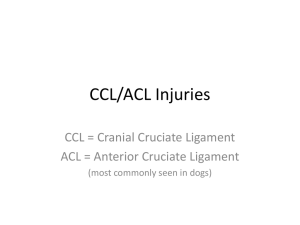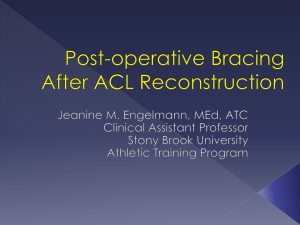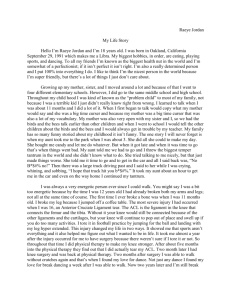RESEARCH PROTOCOL PROTOCOL TITLE: THE INCIDENCE OF
advertisement
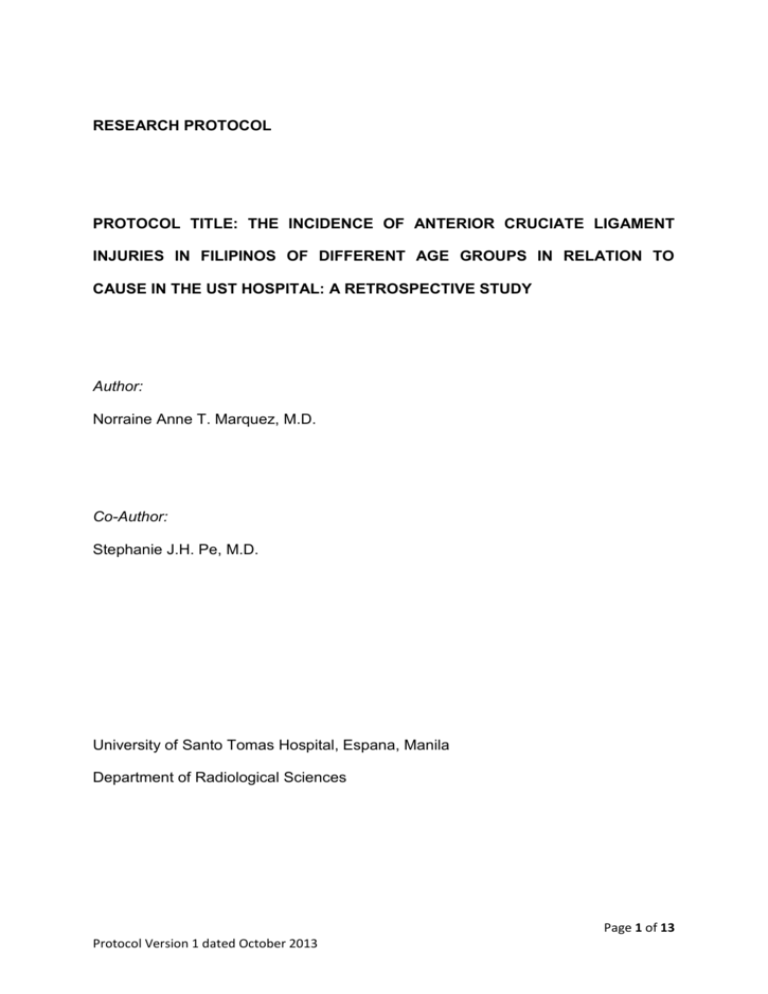
RESEARCH PROTOCOL PROTOCOL TITLE: THE INCIDENCE OF ANTERIOR CRUCIATE LIGAMENT INJURIES IN FILIPINOS OF DIFFERENT AGE GROUPS IN RELATION TO CAUSE IN THE UST HOSPITAL: A RETROSPECTIVE STUDY Author: Norraine Anne T. Marquez, M.D. Co-Author: Stephanie J.H. Pe, M.D. University of Santo Tomas Hospital, Espana, Manila Department of Radiological Sciences Page 1 of 13 Protocol Version 1 dated October 2013 TITILE OF RESEARCH PROPOSAL The Incidence of Anterior Cruciate Ligament Injuries in Filipinos of Different Age Groups in Relation to Cause in the UST Hospital: A Retrospective Study. INTRODUCTION The anterior cruciate ligament (ACL) is the primary stabilizing structure of the knee. It stabilizes the knee by preventing anterior translation and internal rotation of the tibia with respect to the femur. The anterior cruciate ligament originates from the posterior aspect of the femur coursing medially and inserting on the anterior aspect of the tibia. Loss of these restraints leads to substantial morbidity and can result to dysfunction of the other structures in the knee. Injuries to the anterior cruciate ligament are one of the most common knee injuries that are encountered today. These types of injury are most common to athletes. However, sports-related events are not the only possible cause of the injuries to the ACL. They may also be acquired through trauma secondary to fall or motor vehicular collisions as well as idiopathic causes. The overall incidence of anterior cruciate ligament injuries and their causes in the general Philippine population is not known. In the review of the related literature, only few materials referred to the causes and incidence of anterior cruciate ligament injuries in different age groups. The identification of the most common causes of the injuries to the ACL may lead to prevention. Page 2 of 13 Protocol Version 1 dated October 2013 BACKGROUND AND REVIEW OF RELATED LITERATURE The anterior cruciate ligament is a band of dense connective tissue that connects the femur and tibia20. It is enveloped into the synovial membrane of the human knee joint, which by definition places the ligament intra-articular but extrasynovial1,18. It extends from a broad area anterior to and between the intercondylar eminences of the tibia to a semicircular area on the posteromedial portion of the lateral femoral condyle10. The ligament originates at the medial side of the lateral femoral condyle and runs an oblique course through the intercondylar fossa distaanterior-medial to the insertion at the medial tibial eminence 20. The anterior cruciate ligament is composed of two (2) bundles that are named based on their relative attachments on the femur and tibia: an anteromedial bundle (AMB), which is tight in flexion, and a posterolateral bundle (PLB), which is more convex and tight in extension10. The AMB inserts at a more medial and superior aspect of the lateral femoral condyle while the PLB inserts at a more lateral and distal aspect of the lateral femoral condyle13. Occasionally, a third intermediate bundle is appreciated 10, 13. The whole ACL measures approximately 31-38 mm in length and 10-12 mm in width10, 13. The anteromedial bundle is 36.9 ± 2.9 mm in length, while the posterolateral bundle is 20.5 ± 2.5 mm in length. Both bundles are similar in size, with an average width of 5.0 ± 0.7 mm and 5.3 ± 0.7 mm in the mid-substance13. The proximal part of the ACL is supplied by vessels from the middle genicular artery. Distally, the ligament is supplied by branches of the lateral and medial inferior geniculate artery. Proximal and distal vessels support a synovial plexus from Page 3 of 13 Protocol Version 1 dated October 2013 which small vessels run into the ligament and align longitudinally parallel to the collagen bundles24. The main purpose of all joints is to allow for motion of the osseous segments surrounding the joint while being able to withstand the loads against gravitational force imposed by these movements. The knee joint must provide a normal amount of motion without sacrificing stability during static activities to more dynamic functions. These goals are achieved by the interaction of the osseous anatomy, articular surface, ligaments, menisci and surrounding musculature about the knee 10. The anterior cruciate ligament is an important stabilizer of the knee. Due to the orientation of the anterior cruciate ligament, it has been shown to be the primary restraint to anterior tibial translation20. It also serves as secondary restraint to internal rotation of the tibia and valgus angulation of the knee. In full extension, the ACL absorbs 75% of the anterior translation load and 85% between 30 and 90° of flexion10. Loss of the ACL leads to a decreased magnitude of this coupled rotation during flexion and an unstable knee. The overall incidence of ACL injury in the general Philippine population is not known. Rupture of the ACL, unfortunately, is a common sports injury, with a reported incidence of 0.38 per 100,000 individuals23. This generally begins to occur in late adolescence. Younger athletes usually sustain growth plate injuries rather than ligamentous injuries because of the relative weakness of the cartilage at the epiphyseal plate compared with the anterior cruciate ligament 4. Studies have shown a 1.4 to 9.5 times increased of ACL tear in women4. Patients who sustain ACL injuries classically describe a popping sound, followed by immediate pain and selling of the knee. Contact injuries account for 30% of all ACL injuries while noncontact injuries account for the remaining 70% 4. ACL Page 4 of 13 Protocol Version 1 dated October 2013 injuries caused by contact require a fixed lower leg and torque with enough force to cause a tear. Non-contact injuries, on the hand occur primarily during deceleration of the lower extremity, with the quadriceps maximally contracted and the knee at or near full extension. ACL tears may be partial or complete. Partial tears can range from a minor tear involving just a few fibers to a high grade near-complete tear involving almost all of the ACL fibers. A partial tear can involve both or only a single bundle to varying degree. Sometimes plastic deformity of the ACL without fiber discontinuity can occur causing ACL insufficiency22. Most ACL tears (approximately 80%) are complete, occurring around the middle one-third of the ACL (90%) or less frequently close to the femoral (7%) or tibial (3%) attachments. Less frequently (approximately 20%), ACL tears are incomplete with partial disruption of the ACL fibres22. Partial tears may involve only one or both bundles to a varying degree though the anteromedial band does tend to be the more commonly affected. Imaging, and in particular MRI, is very helpful in the assessment of suspected ACL injury13. Radiographs have limited value in the diagnosis of acute anterior cruciate ligament injury. Findings are indirect and limited to bony abnormalities. On radiography, several indirect signs raising the suspicion of ACL injury may be seen which includes avulsion fracture at the tibial insertion or femoral origin lr at the lateral tibial rim (Segond fracture), lateral femoral notch sign, sulcus deeper than 1.5 mm and increased opacity in the suprapatellar pouch with fat fluid level (lipohemarthrosis)23. The anterior cruciate ligament can also be visualized by CT scan imaging however, its demonstration is impaired in the presence of hemarthrosis. However, Page 5 of 13 Protocol Version 1 dated October 2013 ACL avulsion injury by is seen by radiography, CT may be helpful in determining the size and comminution of the avulsion bone fragment. MRI is highly accurate at diagnosing ACL tears with accuracy, sensitivity and specificity of more than 90%. MRI sequences applied for optimal visualization of the ACL are 2D fast spin echo sequences either with or without fat suppression. Different planes are used for anatomical correlation. In most institutions, the sequences used to visualize ACL include Turbo spin echo (TSE) sagittal intermediate weighted sequence either with fat suppression and non-fat suppression, TSE coronal T2 weighted fat suppression sequence and TSE axial intermediate weighted with fat-suppression sequence. The normal ACL should have a taut, low to intermediate signal intensity with continuous fibres in all planes and sequences. It courses parallel or steeper than the intercondylar line. The PLB usually has higher signal intensity than the AM bundle13. Primary sign of an ACL tear is discontinuity which was defined as a focal gap in the ligament or depiction of more than one ligament piece11, 13. Partial tears are more difficult to diagnose and are characterized by increased signal intensity and fiber laxity with increased concavity or bowing of the ACL13. Secondary signs of an anterior cruciate ligament injury include bone contusions or bruises, deep lateral femoral notch sign, Bosch-bock bump, anterior tibial translation, femorotibial translation and rotation resulting to buckling of the patellar tendon, buckling of the posterior cruciate ligament (PCL), a posterior PCL line, and uncovered posterior horn of the medial or lateral meniscus4, 11-13. Page 6 of 13 Protocol Version 1 dated October 2013 OBJECTIVES GENERAL OBJECTIVE: The main purpose of this paper is to retrospectively compile data regarding the injuries to the anterior cruciate ligament in patients of different age groups who underwent MRI of the knee in the UST Hospital and establish the most common causes. SPECIFIC OBJECTIVE (S): - This research will focus in patients diagnosed with ACL sprain, partial tear and complete tears. - Etiologies or mechanism of injury will be correlated to the injury acquired. - Establish the most common causes of injuries in the anterior cruciate ligament occurring in Filipinos of different age groups. STUDY DESIGN DESIGN: Retrospective Study SETTING: University of Santo Tomas Hospital STUDY POPULATION: Patient from the period of January 2009 to December 2013 who underwent MRI of the knee and diagnosed with anterior cruciate ligament injury SUMMARY This will be a retrospective study of patients who were diagnosed with anterior cruciate ligament injury, which includes partial tear, sprain of complete tears, after Page 7 of 13 Protocol Version 1 dated October 2013 undergoing MRI of the knee from the period of January 2009 to December 2013 in the Department of Radiological Sciences at the University of Santo Tomas Hospital. The age of the patients as well as their respective pertinent medical histories as to the causes of their respective injuries as seen in the MRI database will be reviewed for completeness of the patient’s entries. All data for the study will be acquired from the digital files of the MRI section of the University of Santo Tomas Hospital. Likewise, the approval from concerned authorities with attention to confidentiality (patient data-identification process) will be practiced. DATA MANAGEMENT AND STATISTICAL ANALYSIS The stratified sampling method will be used in selecting the included subjects in this study. The data acquired will be analyzed by descriptive statistics and frequency distribution, while the measure of association between the data will be assessed using the Pearson correlation coefficient. INCLUSION CRITERIA 1. Patients who underwent MRI of the knee from the period of January 2009 to December 2013 in the MRI section of the University of Santo Tomas Hospital. 2. Interpretation or official MRI result revealed a definite injury to the anterior cruciate ligament, whether it is a sprain, partial tear or complete tear. 3. Patients with no previous diagnosis of ACL injury. 4. Patients aged 13 years old and above. Page 8 of 13 Protocol Version 1 dated October 2013 5. Data of the patient as recorded in the MRI database includes the history of the patient, i.e. chief complaint, activity prior to symptoms. EXCLUSION CRITERIA 1. Interpretation or official result of the knee MRI revealed inconclusive findings. 2. Incomplete information in the MRI database and/or records. 3. Patients on follow-up with previous diagnosis of anterior cruciate ligament injury and those who received therapeutic intervention. After careful evaluation and screening of each patient, the final study population of this study will only be composed of the patients that have met all the criteria, as specified above. ETHICAL CONSIDERATIONS DUTY OF CONFIDENTIALITY The research, being retrospective in nature, will only deal with pre-collected data in the form of the subjects’ individual medical histories as well as the MRI digital images and results of the eligible patients. The patient’s privacy will be protected as their identities will not be revealed nor any personal information be disclosed when the study is published or presented. The anonymity and confidentiality of the subjects will be maintained before, during and after the completion of this study. All data collected will only be used for research purposes. Breach of confidentiality may occur if the information of the patients included in this study will be used in any other way. Page 9 of 13 Protocol Version 1 dated October 2013 INFORMED CONSENT Authorization to access the medical information of all included patients is approved by the chairman of the department. As this study will only be a review of the records kept by the department, no informed consent from each participant will be undertaken. DECLARATION OF INTEREST The authors of this retrospective study declare that there is no conflict of interest that could be perceived as prejudicing the impartiality of this scientific study. FUNDING This study will not receive any grant for its completion from any funding agency from the public, commercial or not-for-profit sectors and any expenses will be paid for by the investigators. BUDGET ITEMS AMOUNT Office Supplies and Material 500.00 Php Photocopying/Printung Expenses 500.00 Php Statistician 2,300 Php TOTAL 3,300 Php Page 10 of 13 Protocol Version 1 dated October 2013 REFERENCES 1. Amockzy, S.. Anatomy of the Anterior Cruciate Ligament. Clinical Orthopedics 1983; 172: 19-25. 2. Arendt, M.D., E., Agel, J. & Dick, R.. Anterior Cruciate Ligament Injury Patterns Among Collegiate Men and Women. Journal of Athletic Training 1999; 34 (2): 86-92. 3. Besette, M.D. and Hunter, M.D., R.. The Anterior Cruciate Ligament. Orthopedics 1990; 13: 551-562. 4. Cimino, M.D., F., Volk, M.D., & Setter, D.. Anterior Cruciate Ligament Injury: Diagnosis, Management and Prevention. American Academy of Family Physicians. 2010. www.aafp.org/afp. 5. Crema, M.D., Roemer, M.D., F., et al.. Articular Cartilage in the Knee: Current MR Imaging Techniques and Applications in Clinical Practice and Research. Radiographics 2011; 31: 37-62. 6. Dalinka, M.D., M., Gohel, M.D., V., and Rancier, M.D., L.. Tomography in the Evaluation of the Anterior Cruciate Ligament. Radiology 1973; 108: 31-33. 7. Duin, J.. Anterior Cruciate Ligament Injury: Pre- and Post-operative Rehabiltation. Dubin Chiropractic. 8. Hayes, M.D., C., Brigido, M.D., M., et al.. Mechanism-based Pattern Approach to Classification of Complex Injuries of the Knee Depicted at MR Imaging. Radiographics 2000; 20: S121-S134. 9. Kim, M.D., K., Laor, M.D., T., et al.. Anterior and Posterior Cruciate Ligaments at Different Ages: MR Imaging Findings. Radiology June 2008; 247: 826-835. Page 11 of 13 Protocol Version 1 dated October 2013 10. Kweon, C., Lederma, E., and Chhabra, A.. The Multiple Ligament Injured Knee: A Practical Guide to Management. Chapter 2 - Anatomy and Biomechanics of the Cruciate Ligaments and Their Surgical Implications. Springer Science 2013 http://www.springer.com/978-0-387-49287-2. 11. Lee, M.D., K., Siegel, M.D., M., et al.. Anterior Cruciate Ligament Tears: MR Imaging-Based Diagnosis in a Pediatric Population. Radiology 1999; 213: 697-704. 12. Mesgarzadeh M.D., M., Schneck, M.D., and Banakdarpour, A.. Magnetic Resonance Imaging of the Knee and Correlation with Normal Anatomy. RadioGraphics July 1988; 8 (4): 707-733. 13. Ng, W., Griffith, J., et al.. Imaging of the Anterior Cruciate Ligament. World Journal of Orthopedics 2011; 2 (8): 75-84. 14. Oie, M.Sc, E., Nikken, M.D., J., et al.. MR Imaging of the Menisci and Cruciate Ligaments: A systematic Review. Radiology 2003; 226: 837-848. 15. Petersen, W. and Tillmann, B.. Anatomy and Function of the Anterior Cruciate Ligament. Orthopedic 2002; 31:710-718. 16. Prince, J., Laor, T., and Bean, J.. MRI of Anterior Cruciate Ligament Injuries and Associated Findings in the Pediatric Knee: Changes with Skeletal Maturation. American Journal of Radiology 2005; 185: 756-762. 17. Recondo, M.D., J., Salvador, M.D. E., et al.. Lateral Stabilizing Structures of the Knee: Functional Anatomy and Injuries Assessed with MR Imaging. Radiographics 2000; 20:S91-s102. 18. Reiman, P. and Jackson, D.. Anatomy of the Anterior Cruciate Ligament, in Jackson, D., Drez, D. (eds): The Anterior Cruciate Deficient Knee. St. Louis, CV Mashy & Co. 1987: 17-26. Page 12 of 13 Protocol Version 1 dated October 2013 19. Remer, M.D., R., Fitzgerald, M.D., S., et al.. Anterior Cruciate Ligament Injury: MR Imaging Diagnosis and Patterns of Injury. Radiographics 1992; 12: 901-915. 20. Robertson, P., Schweitzer M.D., M., and Bartolozzi M.D., A.. Anterior Cruciate Ligament Tears: Evaluation of Multiple Signs with MR Imaging. Radiology 1994; 193: 829-834. 21. Tung M.D., G., Davis M.D., L., et al.. Tears of the Anterior Cruciate Ligament: Primary and Secondary Signs at MR Imaging. Radiology 1993: 188: 661-667. 22. Vahey, T., Broome, D., et al.. Acute and chronic tears of the anterior cruciate ligament: differential features at MR imaging. Radiology 1991; 181: 251-253. 23. Wong, J., Khan, T., et al.. Anterior Cruciate Ligament Rupture and Osteoarthritis Progression. The Open Orthopedics Journal 2012; 6, (Suppl 2: M6): 295-300. 24. Zantop, T., M.D., Petersen, W., M.D., et al.. Anatomy of the Anterior Cruciate Ligament. Operative Techniques in Orthopedics 2005; 15:20-28. Page 13 of 13 Protocol Version 1 dated October 2013
